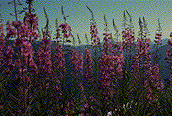Archived Content
Information identified as archived on the Web is for reference, research or recordkeeping purposes. It has not been altered or updated after the date of archiving. Web pages that are archived on the Web are not subject to the Government of Canada Web Standards. As per the Communications Policy of the Government of Canada, you can request alternate formats on the Contact Us page.
Fir - Fireweed Rust
Pucciniastrum epilobii G. Otth.
(=Pucciniastrum fuchsiae Hiratsuka)
Basidiomycotina, Uredinales, Pucciniastraceae
Hosts: In B.C., the aecial hosts of Pucciniastrum epilobii are amabilis fir, white fir, and subalpine fir. Elsewhere in North America it is also reported on grand fir and balsam fir.
The alternate (telial) hosts in B.C. include several species of fireweed (Fig. 38a), godetia (Clarkia amoena (Lehm.) A. Nels), and fuschia.
Distribution: This fungus is widely distributed throughout the range of its hosts in B.C.
Identification: The infected needles of fir become chlorotic or discoloured and may be shed prematurely. Consequently, infected trees show symptoms of needle necrosis and thinning foliage. Spermagonia appear in the spring as small black dots on the lower surface of new needles. These are followed by cylindrical aecial pustules on the lower surface of current years needles (Fig. 38b). After aeciospore discharge in early summer, aecia persist until needles die and are shed. Uredinia are produced on the lower surface of leaves on the alternate host, appearing as pustules that produce yellow-orange urediniospores (Fig. 38c). In late summer, telia form as flat, dark-coloured crusts on lower leaf surfaces.
Microscopic Characteristics: Aecia on current years needles or cone scales hypophyllous, peridermioid, cylindric-flat cylindric, 0.12-0.03 mm in diameter; and 1.0 mm high, aeciospores yellow, catenulate, finely verrucose, 15 x 19 µm, with an elongate smooth spot.
Urediniospores with orange-yellow contents, sparsely and finely echinulate, 13-18 x 17-24 µm; telia hypophyllous, subepidermal, dark coloured.
Damage: Damage to fir varies from year-to-year, depending on local environmental conditions and the proximity of the alternate host. Serious levels of defoliation and mortality have occurred in young stands growing in recently logged areas where fireweed is abundant.
Remarks: A number of other needle rusts are found on fir that could be confused with P. epilobii. These include:
|
fir - blueberry rust |
Pucciniastrum goeppertianum (Kühn) Kleb. |
|
common fir - bracken rust |
Uredinopsis pteridis Dietel & Holw. in Dietel |
|
Hashioka's fir - bracken rust |
Uredinopsis hashiokai Hiratsuka |
|
fir - ladyfern rust |
Uredinopsis longimucronata Faull |
|
fir - willow rust |
Melampsora abieti-capraearum Tub. |
These rusts are superficially similar, but can be differentiated by careful examination of aecia shape, aeciospore colour, and the location of foliar damage.
Pucciniastrum epilobii can become perennial in fireweed, overwintering in the roots, and reinfecting leaves as they develop the following year.
References:
Bauman, N. G. and E. Wegwitz. 1972. Needle rusts of the true firs in British Columbia. Can. For. Serv., Forest Pest Leaf. No. 45. Victoria, B.C.
Ziller, W. G. 1974. The tree rusts of western Canada. Can. For. Serv., Publ. No. 1329. Victoria, B.C.
Figures
Click on any image to see the full size version. Press "Back" on your browser to return to this screen.
 Figure 38a: Fireweed, the most common telial host of Pucciniastrum epilobii.
Figure 38a: Fireweed, the most common telial host of Pucciniastrum epilobii.
Figure 38b: Aecia on subalpine fir needles.
Figure 38c: Uredinia of P. epilobii on the lower surface of a fireweed leaf.
 This Web page has been archived on the Web.
This Web page has been archived on the Web.